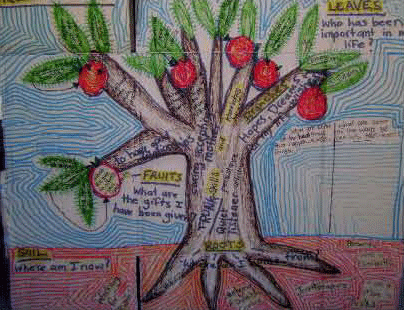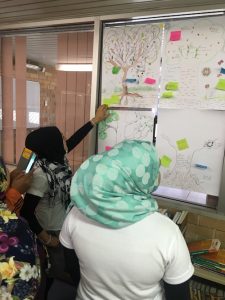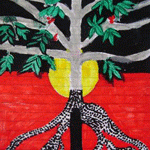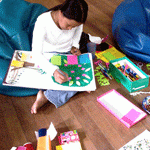
The Tree of Life methodology, developed by Ncazelo Ncube (REPSSI) and David Denborough (Dulwich Centre Foundation), has now been used in many countries around the world.
Over time, we will add stories and accounts from workers and communities in Australia who are using the Tree of Life to respond to various forms of trauma and hardship.
(To read more about the Tree of Life, click here. To read more about where the Tree of Life has been used around the world, click here.)
Tree of Life with young Muslim women
 The Tree of Life project was recently facilitated with a group of young Muslim women from a Western suburbs High School, in Sydney. The project was delivered over 4 weeks, one day each week. The 4 week program was designed around the Tree of Life project by Social worker’s Lobna Yassine and Ola Elhassan. It was a fantastic opportunity to share stories that represented strength, peace, solidarity and determination. A lot of discussion was facilitated around the relevance of trees in Islam, as well as Islamic understandings of hardship and how to get through hard times. The young women advised one another about overcoming difficulties, and shared strategies and ideas.
The Tree of Life project was recently facilitated with a group of young Muslim women from a Western suburbs High School, in Sydney. The project was delivered over 4 weeks, one day each week. The 4 week program was designed around the Tree of Life project by Social worker’s Lobna Yassine and Ola Elhassan. It was a fantastic opportunity to share stories that represented strength, peace, solidarity and determination. A lot of discussion was facilitated around the relevance of trees in Islam, as well as Islamic understandings of hardship and how to get through hard times. The young women advised one another about overcoming difficulties, and shared strategies and ideas.
This particular TOL project included innovations that the young women thoroughly enjoyed such as guest speakers from the Muslim community who also shared their own stories, as well as the addition of the Islamic rose beads in the grounds section of the tree. Of the guest speakers, one of the young women said “It felt good, it felt like we were all going through something similar, and by talking about it, I felt like I wasn’t alone”. The program ended with a celebration that involved their families. The families were ecstatic to witness their daughters and sisters achieve the TOL award. They were also pleased to see that they had made it onto their daughters’ roots or leaves!
Tree of Life Women’s Group – Elizabeth
 The Tree of Life Women’s Group from Elizabeth, South Australia, has used Collective Narrative Practices (including art and gardening) to honour their own and others’ skills and knowledge in responding to tough times. Our group consists of Aboriginal and non-Aboriginal women. We focus on honouring the Kaurna culture/skills past, present and future. The group was developed and conducted in partnership with Aboriginal and non-Aboriginal facilitators. As well as making our Trees of Life, we made a food and medicine garden using Indigenous plants of the area. These plants serve as a metaphor for our lives – these plants have survived out here despite many ‘storms’. Read more …
The Tree of Life Women’s Group from Elizabeth, South Australia, has used Collective Narrative Practices (including art and gardening) to honour their own and others’ skills and knowledge in responding to tough times. Our group consists of Aboriginal and non-Aboriginal women. We focus on honouring the Kaurna culture/skills past, present and future. The group was developed and conducted in partnership with Aboriginal and non-Aboriginal facilitators. As well as making our Trees of Life, we made a food and medicine garden using Indigenous plants of the area. These plants serve as a metaphor for our lives – these plants have survived out here despite many ‘storms’. Read more …
Exploring the Tree of Life with Women From Burma
 Manon van Zuijlen ran the Tree of Life workshop with a group of women from rural and remote parts of Burma, who had been in Australia for less than two years and were all still learning English. This project, held over several weeks, involved a visiting artist who taught painting techniques which the group used to illustrate their trees. The workshops ended with a celebratory party where the women spoke about their trees – and their lives – to the assembled guests, in a very moving definitional ceremony. Read more …
Manon van Zuijlen ran the Tree of Life workshop with a group of women from rural and remote parts of Burma, who had been in Australia for less than two years and were all still learning English. This project, held over several weeks, involved a visiting artist who taught painting techniques which the group used to illustrate their trees. The workshops ended with a celebratory party where the women spoke about their trees – and their lives – to the assembled guests, in a very moving definitional ceremony. Read more …
Working with young men negotiating authority
 Deb Toumi from Lifeline Community Care Queensland ran the Tree of Life with a group of 13 and 14 year-old young men who had experienced various struggles with ‘authority’ – whether at school, with the law, or in their families. Many of these young men were from separated families and some were in care. The group, including both Indigenous and non-Indigenous young men, were quick to identify some of the ‘storms’ that can visit young people’s lives, as well as their skills in negotiating these. This project led to the local High School adoping the Tree of Life as part of its mission of becoming a ‘school of excellence’.
Deb Toumi from Lifeline Community Care Queensland ran the Tree of Life with a group of 13 and 14 year-old young men who had experienced various struggles with ‘authority’ – whether at school, with the law, or in their families. Many of these young men were from separated families and some were in care. The group, including both Indigenous and non-Indigenous young men, were quick to identify some of the ‘storms’ that can visit young people’s lives, as well as their skills in negotiating these. This project led to the local High School adoping the Tree of Life as part of its mission of becoming a ‘school of excellence’.
To read the booklet that Deb and the young men produced to document their conversations, click here.
If you want to print out this booklet to use with young people, this version has been designed to be printed out back-to-back and folded and stapled down the spine. The pages will appear out of order on screen but will be in order when made up into a ready-to-use booklet.
Working with communities that have experienced trauma using the Tree of Life concept
After attending training in the Tree of Life and collective narrative practice, Peter Read used the Tree of Life in his work with Vietnamese men. All of these men used mental health services, and many had experienced trauma. Most had come to Australia in the aftermath of the Vietnamese war – often in open boats. However, many were being treated for ‘conditions’ that did not have equivalent concepts in their language or culture of origin. The Tree of Life provided an alternative, ‘experience-near’ way for the men to speak about the traumas they had experienced, as well as how they had responded to them. To read Peter’s report of this work, click here…
Celebrate Recovery PhotoVoice project
Viviane Oliveira co-faciltated workshops with Miriam Bevis based on the Tree of Life as part of the Celebrate Recovery Program held at Mt Druitt Indigenous Church. These innovative workshops were run as part of a ‘PhotoVoice’ project, where participants told stories from their lives using photographs. Each week, participants were taught different aspects of photography, and then completed personal photography projects during the week, which they then shared the next time the group met. To read more about this project, click here.
To find out about training in the Tree of Life approach, click here.

Lydia
March 22, 2023Can I facilitate Tree of Life without have a certification in it
Leanna Wilson
August 5, 2022Hi
I’m interested in participating in tree of life specific to aboriginal communities.
Do you offer online training?
I’m based in outer east Melbourne vic
Kim Norris
May 17, 2021Good afternoon.
I’m writing today because I’m in the process of writing a Social and Emotional Learning program for schoolchildren, and would like to include the Tree of Life components in the first week addressing Self-Concept, and throughout the program further addressing relational and emotional contexts and experiences. My question is whether there is a copyright issue to do this?
Thanks for your assistance,
Kim Norris
Brenda
March 5, 2021I have found the tree of life to be a fantastic tool for people from all backgrounds, an simple metaphor (regardless of literacy levels) to understand and the drawing assists the resonation of new stories and where individual hopes and wishes come from. Townsville, Queensland, Australia.
Sbongile
July 7, 2020Hi I am in South Africa Johannesburg it has been wonderful to learn that Narrative therapy- Tree of Life have been adapted and found useful in different cultures, races , age group and gender where people are encouraged to drew their trees and tell their stories in a way that made the strong.
Sharon Taylor
September 16, 2018Hi,
I live in Perth and am wondering if the Tree of Life is being used in WA yet. It looks like a wonderful, holistic, culturally sensitive and life-giving approach to foster communication and healing. I am on the Expert Panel working towards a Recovery College in WA, and have seen that the Camden and Islington Recovery College is using the Tree of Life very effectively in their work.